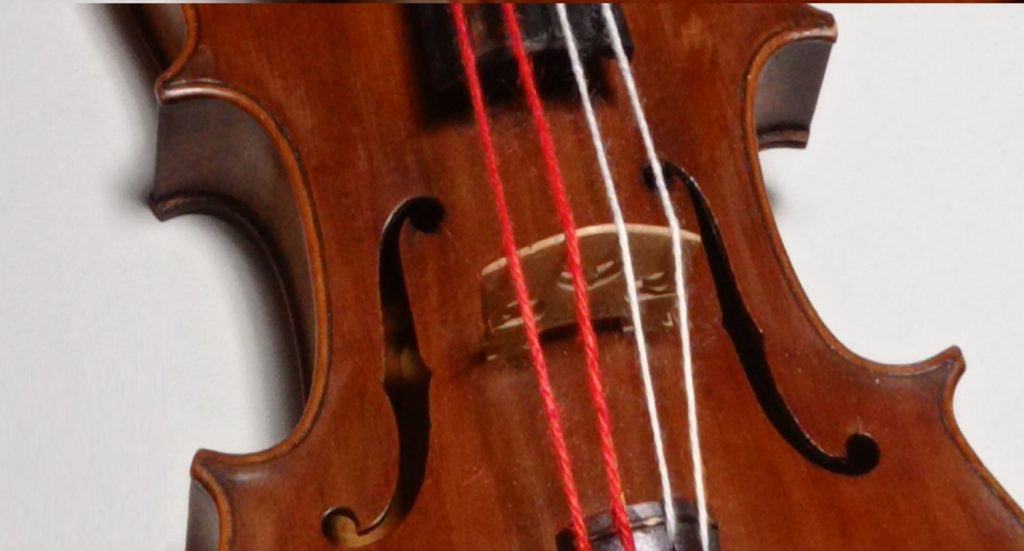
In the following article, I would like to give a brief overview of the results of my work on my arrangement of Karol Szymanowski’s Pieśni Kurpiowskie Op.58 [Kurpie Songs] from the position of an instrumentalist who likes to reach for music from stylistically distant eras and genres. It took me many years to become mature enough to listen to the music of Karol Szymanowski. As a performer and arranger, in 2019 I had an occasion to work on the song cycle in question – I prepared seven selected songs for a trio consisting of soprano, piano and viola. I added a viola part to the two original parts, duplicating the parts of the piano’s right or left hand where they were most characteristic – worth amplifying, or those that were disappearing in the dense, quasi-cluster piano texture of some of the songs. The achieved effect encouraged me to explore Opus 58, and made me realize that half-measures would not work in this case. Had I simply transcribed the vocal part to the alto key with suggested positions and bowing, I could not call it my arrangement, so I moderately benefited from a wide range of available means to select those that match the style of the cycle in question. My latest work (2021) combines elements of transcription, arrangement, composition, recomposition and notated improvisation. In all 12 songs, I added short introductions for viola solo or with piano, using different styles and conventions, in a postmodern spirit. My intention was to limit intrusion into the original form of the songs to the necessary minimum – I allowed for the addition of introductions before the first bars and possibly tiny motifs in the end. I made exceptions to this rule only when I was confident that a given modification would not be extravagant and would be based on Szymanowski’s material, multiplying it (I broke this rule in the original cadence at the end of song 9).
I relied on 19th- and 20th-century source materials. Szymanowski himself took music samples of songs from the Puszcza kurpiowska w pieśni [The Kurpie Forest in Song] by Rev. Władysław Skierkowski (published in 1928-1934). When I began exploring the above topic, I assumed that Szymanowski used mainly the 27th volume of Oskar Kolberg’s Dzieła Zebrane [Complete Works] (Mazowsze, Volume 4: Mazowsze Stare. Mazury. Kurpie). Kolberg’s work (1888) was a valuable source of inspiration and imagery for me, helpful to interpretation of my version of the song on stage. In the collective work entitled Z życia i twórczości Karola Szymanowskiego [From the Life and Oeuvre of Karol Szymanowski] published by the Instytut Sztuki PAN, PWM (1960), there was a useful article by Zofia Lissa Rozważania o stylu narodowym w muzyce na materiale twórczości Karola Szymanowskiego [Reflections on the National Style in Music based on Karol Szymanowski’s Works] depicting the circumstances of Szymanowski’s maturing into the third , the so-called national phase of his work, as well as Bożena Motylewska’s article Elementy modalne w twórczości Karola Szymanowskiego [Modal Elements in Karol Szymanowski’s Works] shedding light on the hybrid, polymodal language of the songs from the 58th opus, in which Szymanowski interspersed the major-minor system with modal scales and pentatonics. He also harmonizes the songs in accordance with the original material and partially introducing stylizations as part of the reharmonization. In 20th-century Polish music, following Szymanowski’s example, later composers were very fond of Podhale and Kurpie folklore. In her article on Podhale and Kurpie elements in Polish compositions of the 20th century, Bogumiła Mika provides the following examples of inspiration from Kurpie music: Roman Maciejewski – Pieśni kurpiowskie, Andrzej Panufnik – Sinfonia Rustica, Michał Kondracki – Suita kurpiowska, Bolesław Szabelski – Trzecia Symfonia, Kazimierz Serocki – Symfonia Pieśni (II), Witold Rudziński – Pieśni kurpiowskie, or Paweł Łukaszewski – Pięć żałobnych pieśni kurpiowskie and Impresje kurpiowskie. The songs from opus 58 were arranged for numerous instrumental versions: for violin with piano (by R. Padlewski, I. Dubiska, P. Kochański), orchestral versions (by Fitelberg and K. Wiłkomirski, among others) or for voice and orchestra. Another significant folk music project worth mentioning here is the one devoted to Opus 58 – Etnofonie kurpiowskie. Weronika Grozdew-Kołacińska invited many leading ensembles and soloists of the ethno scene to record an album which is available at the Museum of Kurpie Culture in Ostrołęka – the most important Kurpie center today.
At this point, a forgotten work by Roman Padlewski deserves mention – Suita kurpiowska [Kurpie Suite] for violin and piano based on songs 1, 6, 8 and 11 from the cycle in question. This piece, composed five years after Szymanowski’s death as a tribute to his work, most faithfully reproduces the style of his master. Padlewski makes use of all the technical and expressive means developed by Szymanowski, characterized by both composers’ profound knowledge of the possibilities of the violin, and the performance idiom. Based on selected songs, Padlewski wrote virtuoso miniatures that draw on Szymanowski’s virtuoso violin language, known for example from his Violin Concerto No. 2, String Quartet No. 2, Myths, or the Dance from Harnasie, arranged for violin and piano together with Paweł Kochański.
Szymanowski’s style can sometimes be difficult for listeners because of the harmonic language – seemingly monotonous in its complexity and full of dissonances. In my arrangement, I sought to make the overall mood of these works more accessible by combining familiar harmonies or styles with the substance of the songs (this is sometimes called “creative betrayal”). I added an introduction to each song, which is usually intended to put the listener in a positive mood and move unobtrusively to the song itself, sometimes based on Szymanowski’s original material and sometimes on my invention. Postmodernism gives a green light to all combinations of styles and eras. The very existence of “neo-” trends in music (neo-classicism, neo-baroque music, neo-romanticism) shows that humanity loves to return to the past and creatively adapt and modify it. Szymanowski himself added an expressionist, oneiric accompaniment to Niccolò Paganini’s three caprices from Op.1.
My idea of a perfect arrangement was mostly influenced by three instrumental miniature cycles: the aforementioned Padlewski Suite, Manuel de Falla’s Siete canciones populares españoles, and Bela Bartók’s Romanian Dances – in the version for violin and piano. De Falla arranged existing songs from various regions of Spain for soprano and piano, while the violin version was edited in collaboration with Paweł Kochański. Bela Bartók’s cycle exploits flageolets, double-stop and chord textures or changes of registers. The means used by the above-mentioned artists, in my opinion, are the most balanced and should serve as an example.
Contemporary rhetoric is the term I would choose to describe the ideas of arrangement and recomposition I use in the 12 songs. To me it was important to use illustrative means, such as descending glissandos to depict sighs; harmonics associated with archaism, simplicity, nostalgia; pizzicati to diversify the arco parts; tremolos to express excitement; sul tasto to represent remoteness; non vibrato playing with a rustic character. Textural changes determine the internal differentiation of the character of the piece – double-stop texture highlights the role of harmony in the presentation of the melody; figurations with increased motorics inform about the agitation of the lyrical subject or the acceleration of the narrative; the use of chordal texture enhances the energy of a passage; bourdon notes add jolly folk character; changes of registers in relation to the original – in addition to the important function of adaptation to specific instruments, they also allow to complement fragments transposed by an octave or octaves with appropriate emotions and color.
As I present my original arrangement of songs from Opus 58, I will briefly discuss the introductions I composed and the modifications I made to the original score based on experience in theory and practice rather than standard compositional education.
I came across the Lecioły zórazie song in my childhood years thanks to the ethno-jazz album named Recital by Michal Urbaniak and Wladyslaw Sendecki. It is used in the piece Variations on folk song (in five of the six variations). The first three bars of my introduction played tremolo, and the last four bars, the so-called “outro” – a quote from the melody of the first variation from the aforementioned album – is my tribute to Urbaniak’s arrangement. His vision gave me courage to use a style similar to this of pop music, with strong dynamics and rich in contrasts. I added an introduction based on shorter and faster fragments – three bars, then two, and finally one. The meter changes a lot – 3/4, 5/4, 9/8, 3/8, the pulse accelerates gradually: a quarter equals approximately 60, 100, 120, 180 (this in the case of writing three bars on 3/8 in eighth-note motion on 3/4), 60 – back to primo tempo. The keys change in the progression of the minor third – F major, A flat major, C flat/B major, D major, F major.

Further in the introduction, the first two bars of the solo piano part are duplicated; on this background appears a lively pizzicato four-bar section based on rhythmically modified melodic material taken from the accompaniment.

In the song that opens the cycle, you will not find sharp contrasts, but subtle nuances that differentiate the individual stanzas. At the expense of songfulness, I propose a version of the first three stanzas in two-note texture, completing the harmony with sounds from the piano part. This emphasizes the evolution of modal harmony and intensifies the presence of dissonances, which remain unresolved for a longer while.

Szymanowski commences the song with a poetic phrase in triple meter, full of metric shifts, a blurred pulse, transpositions and syncopations, in the dreamy character of a kujawiak. In the version for viola, the rhythmic layer is simpler – no ligatures, syncopations, dotted rhythms; in its primitive character the melody resembles oberek, which implies a slightly different distribution of harmony. I transposed my introduction to Doric D minor, so that after the 10-bar passage it can arrive in the key of the original introduction (Doric B minor). The last bar of my introduction alludes to the motif from the first song, and is at the same time (with bar 9) a two-bar quote from the 1st movement of Vivaldi’s Spring, imitating the singing of a bird.

I replaced the eight bars of pauses in the solo voice with a pizzicato accompaniment on the eighth notes in piano.

In order to achieve a noticeably contrasting character of the stanzas, the dramatic tension, which in the vocal version grows in the text, has been replaced by the instrumental layer that suggests the development of the narrative. This strategy is visible throughout the whole cycle. In the original version, the first stanza is a lively, carefree melody. The second stanza uses a variation technique that adds figuration in sixteenth note motion to the melody; the way quarter notes and half notes are figurated is particularly interesting.

The third stanza is figurated in the first half only in order to show the descent from the motoric climax as an illustration of the apathetic resignation of the lyrical subject. Such an energetic regression can be seen in most of the songs (1, 2, 4, 5, 7, 8, 9, 10 and 12). Simultaneously, in terms of agogics, there is a gradual, cascading rallentando slowing down the narrative step ny step – poco meno, meno mosso. The primo tempo returns only in the ending (the last ten bars) based on the second half of the poetic introduction, which gives the impression that throughout the song the agogic means successfully compensated for the lack of text. The music suggests some hidden drama, while the text of the song shows a happy ending – the main character found shelter from the storm, and the downwards glissando at the very end of the song symbolizes a sigh of relief.
I based the introduction on a simplified, quasi-archaic version of the main melody, presented in the highest register of the viola thanks to the yearning emission of the quartet harmonics. The piano plays the same melody in a similar register in eighth-note figuration. After an eight-bar phrase, the instruments exchange parts. From bar 17 on, the introduction fades away in aesthetics reminiscent of film music, smoothly and unnoticeably moving on to the original text of the song.
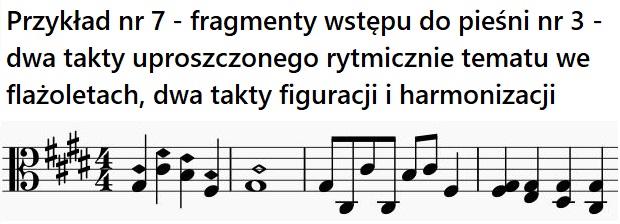
The long introduction compensates for the lack of modification in this song – the viola part is developed with fingering and bowing in such a manner that changes in dynamice (from pp-p to ff-fff), timbre and emotional intensity (from flautando/lontano/tranquillo to molto espressivo/dolente/fuocoso) are as smooth as possible and graded with maximum rigor.
My original 17-bar virtuoso introduction, based on a two-bar motif of the stanza melody, takes the form of three phrases in the form of ostinato variations – the first with a bourdon, the second in a sixteenth-note figuration, the third on harmonized arpeggios. All three have dense double-stop texture; the alternate version of the first and fragments of the second contain triple-stops.

Szymanowski’s original introduction for piano solo features the minor harmony in double-stop texture, enriched by delayed resolutions.

A stanza based on contrasting two phrases – the first melancholic and the second piu scherzando – develops the form by gradually raising the melody into higher and higher registers. The six-bar climax from bars 90-95 delighted me so much that I could not let it end in accordance with the original notation, but adopted the scheme of 4 bars + 3 bars + 4 bars, presenting the phenomenal melody in three settings: in forte dynamics, then piano, then in altered agogica – in piano and rallentando.

The abbreviated original introduction returns before the ending. At the beginning (bars 1-12), the piano plays in the high registers and the viola in the lowest, while in the ending (bars 96-102) the registers are switched. The theme returns the last time in a surreal flageolet version – this technique, despite its frequent use throughout the cycle, reveals a different aspect of the flageolet rhetoric each time. Alongside the flageolets, the descending glissando expresses the sigh of a maiden who is forced to refuse a bachelor’s request.
The long introduction compensates for the lack of modifications in this song – the viola part is developed with positions and bowing in such a manner that changes in dynamice (from pp-p to ff-fff), timbre and emotional intensity (from flautando/lontano/tranquillo to molto espressivo/dolente/fuocoso) are as smooth as possible and graded with maximum rigor.
The mood and essence of this song is formed through the juxtaposition of two different feelings – love and uncertainty, illustrated through the same motif appearing in major and minor. My short three-bar introduction, based on the one-bar preface to the original, summarizes and anticipates the lability of the major-minor mode that we can expect in this song.
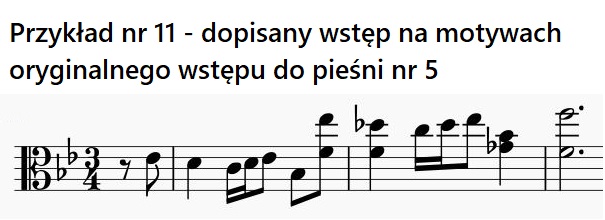
The initial stanzas were enriched with a two-stop and mixed texture, taken from the original piano part, which gave a polyphonic effect in the extensive passages, so that there was no need for additional exposition of the role distribution resulting from the text.

The return to single-voice texture in the last section of the piece allows for a more singable and nostalgic character – an intentional variety in the absence of the verbal laser. At the end I add two incomplete pizzicato chords – in B-flat minor and B-flat major – concluding the entire song.
I repeated the original four-bar introduction. The added voice of the viola is based on the left-hand part in the first four bars, and on the right-hand part of the piano in the subsequent four bars.
The first seven bars of this song, the most dynamic of the entire cycle, are embellished with four-bar chords and bourdon based on the harmony of the piano voice. In the first chord, the three lowest empty strings of the viola are used, resulting in the most sonorous and open sound.
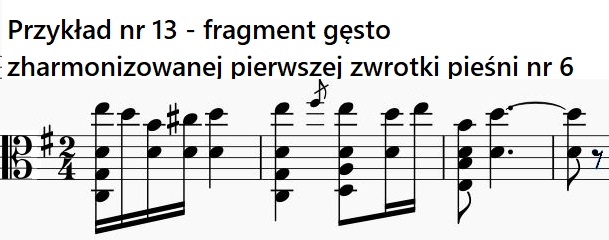
In the following three bars, the term rustico, suggests playing non vibrato with an flag, quasi-folk intonation, for which György Ligeti, for example, could have used in quarter-tone notation (Sonata for solo viola, 1st movement).
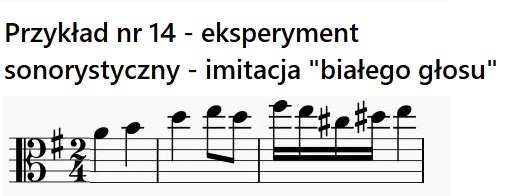
The original development of the song – transposition by a whole tone higher and sophisticated dynamics – piano dolce in place of the initial f/ff corresponds well with the return to single-voice texture. The fortissimo ending does not require harmonization (double stops). In the added ending, the effect of distant horse steps is obtained through four repetitions of the motif from the first bar of the introduction, in unison with piano, with diminuendo and rallentando,. This effect is almost quasi-theatrical and thus welcome in the entire cycle.
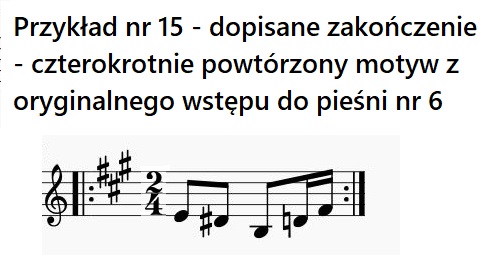
The dramatic content of this song in the instrumental version is based on the masterful handling of timbre (achieved through playing in positions) and expression created through the execution of dynamics – from piano/flautando/lontano/tasto, through forte/fortissimo espressivo and back to piano. The added introduction is based on neo-Baroque harmonic sequences played poco rubato in triple meter – misleading with respect to the original 2/4 meter. The chordal figurations, maintained in sextolets reiterate and announce the B-flat minor key and the quarter note pulse, and are meant to put the listener in a nostalgic reverie corresponding to the mood of the song.

The next passage is the last vocal two bars of the song repeated as an echo – in climatic pianissimo, with a descending glissando played only the last time. It is due to the specific nature of the vocal part and the musical expression of the phrase and song’s ending. In this song, the maiden sighs with longing for her beloved man and with fear of loneliness.

The song is infused with love, bliss, sweetness, it is a love confession, except that the recipient learns that he is not the addressee of these feelings – the girl’s message puts an end to the previous relationship. It is difficult to convey the expressive complexity of these emotions without the help of words.
The three-bar polyphonic introduction in dense mixed texture is based on one of two – a secondary and contrapuntal musical motif, appearing in the vocal part partially and in full only in the piano part.
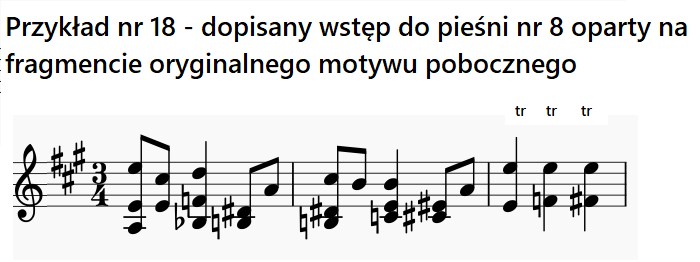
The texture of the entire song is single-voiced, and it is also characterized by varied bowing – an unpredictable grouping of shorter and longer motifs, treated differently each time. The melody obsessively repeats one motif over and over again with original slight interval modifications. The main intervention in this song was to manipulate the registers, different from the original version, in such a way as to overcome monotony and give impression of intensifying the narrative development. The melody goes up constantly, in the last phrase via flageolets, which reflects, on the one hand, the so-called “bright sadness” of the addressee of the confession, whose dream future is ruined and, on the other hand, the bliss of new love of the cruel maiden.
The first transcription of this song for violin and piano was done together with the composer by Pawel Kochański. The successive stanzas did not remain at a single pitch, as in the version for soprano and piano, but ascended from the lowest through the middle to the high register, replacing the development of the text narrative. My guiding principle in arranging this song was to look for unconventional climaxes and to operate the registers in a completely different way – one that was not obvious or expected.
My short four-bar neo-baroque introduction introduces the key of A minor and a quarter note pulse in triplet motion, which will appear in the piano part in the second half of the song. The harmonic succession is based on a fragment of the piano part.

In the greatest climax, a motif that descends twice in two adjacent octaves (bars 53-55) is exposed, perhaps because of the limitations of the voice scale. On the viola it was possible to expand this climax to three repetitions in three octaves.
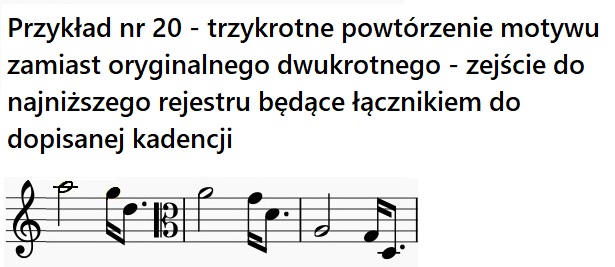
Directly after the climax comes a short, quasi-improvisational cadenza. The space for this is generated by repeating the piano part’s two-bar cadence, which is attractive from an improviser’s perspective, three times, resulting in six bars to be filled. The cadenza ends with a purposefully asynchronously placed chord one bar before the final chord of the piano, thus creating a quasi-theatrical effect of the nostalgic loneliness of the lyrical subject (the protagonist – viola player/soloist and the narrator – pianist), who at the last moment part ways, cutting off the dialogue.

I added a repetition to the original four-bar solo piano introduction, and on the background of the resulting eight-bar I added sixteenth-note figurations in the viola part in unison with the original piano part based on court rhythms, and in the next four-bar the viola fills in the accompaniment with empty chords (prima + fifth) in a thirty-two-note motion.

The individual passages, as the text indicates, convey the utterances of the maiden and the bachelor. I differentiated them minimally not so much by contrast of registers, but by interpretive intention arising from an awareness of whose part is being played when. In the fourth stanza (bars 42-48), I added virtuoso figurations instead of long notes, building the biggest climax in the process.

As for the ending, the indispensable harmonics and the measure known from the ninth song, consisting in repeating the descending through the registers of the motif not twice, but three times, with a glissando illustrating the sigh: “nie na to ja śpsiwum by ludzie słyseli, smutne syrce moje niech się rozwesli” [it is not for people’s ears that I sing, let my heart be cheered]
I added a repetition to the original four-bar solo piano introduction, and on the background of the resulting eight-bar I added sixteenth-note figurations in the viola part in unison with the original piano part based on court rhythms, and in the next four-bar the viola fills in the accompaniment with empty chords (prima + fifth) in a thirty-two-note motion.

The added introduction, based on a one-bar original motif, is elaborated into an exuberant six-bar based on the reproduction of the same motif in an ascending progression based on pentatonic scale. The motif moves through the keys of C major, D major , F major, G major, C major.

In my arrangement of this song, the main stress is on the distribution of roles. Strong contrasts are obtained through dynamics and articulation and the use of different registers. The first stanza is that of the maiden – an utterance in the higher register in piano leggiero with rhythmic-articulatory nuances that distinguish it from the part of the bachelor that is about to follow. Languid glissandos and natural flageolets complete the characterization. The same melody boiling with energy in the lower octave register with an even lower bourdon (C string, occasionally G and D) and pointed rhythms in forte dynamics and energico character portrays the bachelor.

The sigh (glissando) in the end of the song is due to the fact that the love of the maiden receives is conscripted into the army for a quarter of a century, which means a wasted life. To the last chord played by the solo piano, I added a three- or four-note (ossia) sforzato pizzicato in the viola part.
The song begins with a guitar-style pizzicato introduction in an alternating meter of 7/16 and 8/16 emphasizing the reference to the pentatonics scale from the original, which, ninety years after the Kurpie cycle was written, may connote popular music. This is an intended controversy preceding the most hermetic song. The continuation of the introduction in 4/4 meter is followed by a series of chordal figurations based on harmonic successions that consolidate tonality, mode and rhythm (as in the introductions to songs 7 and 9), at times reminding of Bach in character.

The middle two-note fragment harmonized based on the piano part is derived from material far beyond the major-minor system.

I filled the two passages of the piano part playing solo couplings (bars 7-11; 43-48) with pizzicatos based on the material of the piano part (the first passage alludes to Shostakovich’s Sonata for Viola and Piano Part I).

The pizzicato, preceded by an indispensable glissando sigh, is supposed to symbolize tears of happiness over the return of the fiancé from the army.
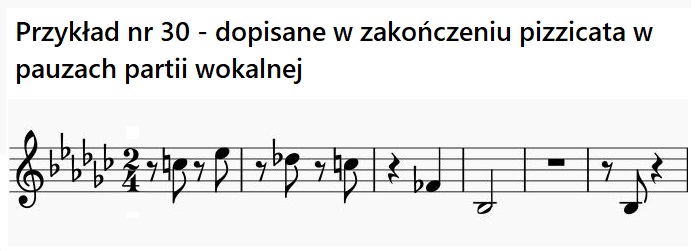
In the original chamber literature and in literature reworked by other artists, the parts of string instruments show consistent common elements. The range of means is not limitless, but the repetitiveness of the arrangement techniques used is not a problem in music – boredom and monotony do not threaten interesting material, even if we see the backstage of the composer’s workshop.
In my arrangement, not only did I emphasize the tonal and expressive qualities of the viola on the one hand, assigning it a cantilena, but also, following the example of the violin, I tried to enrich the viola part with virtuoso elements in texture characterized by double stops, chords figurations. At the same time, the style of the introductions oscillated between Szymanowski’s aesthetics and my impressions drawing on both Baroque forms and film or popular music. The resulting twelve viola miniatures, twelve songs without words, originally collected into three four-part books, in the instrumental version evoke a distant association with sonata form. One can look at songs 1-4, 5-8 and 9-12 as three quasi-sonatas, which may inspire potential performers to emphasize the sonoristic qualities of the viola part.
I hope that my study broadens the canon of viola literature and popularizes Kurpie Songs Op. 58 among instrumentalists.
1. Ks. Władysław Skierkowski, Puszcza Kurpiowska w Pieśni, Wydawnictwo Tow. Naukowego Płockiego, Płock 1934 (Płock : B-cia Detrychowie).
2. Oskar Kolberg, Dzieła wszystkie. Mazowsze, tom IV: Mazowsze Stare. Mazury. Kurpie, Państwowe Wydawnictwo Muzyczne, Kraków 1888.
3. Zofia Lissa, Rozważania o stylu narodowym w muzyce na materiale twórczości Karola Szymanowskiego, w: Z życia i twórczości Karola Szymanowskiego, red. J. Chomiński, Instytut Sztuki PAN, Państwowe Wydawnictwo Muzyczne, Kraków 1960.
4. Bożena Motylewska, Elementy modalne w twórczości Karola Szymanowskiego, w: Z życia i twórczości Karola Szymanowskiego, Instytut Sztuki PAN, Państwowe Wydawnictwo Muzyczne, Kraków 1960.
5. Bogumiła Mika, Elementy podhalańskie i kurpiowskie w wybranych kompozycjach polskich XX wieku, w: Kultura ludowa źródłem działań artystycznych, badawczych i naukowych, red. M. Szyndler, Wydawnictwo Uniwersytetu Śląskiego, Katowice 2015.
PBT Podgórskie Biuro Tłumaczeń
ul. Kielecka 29B, 31-523 Kraków
www.pbt.com.pl